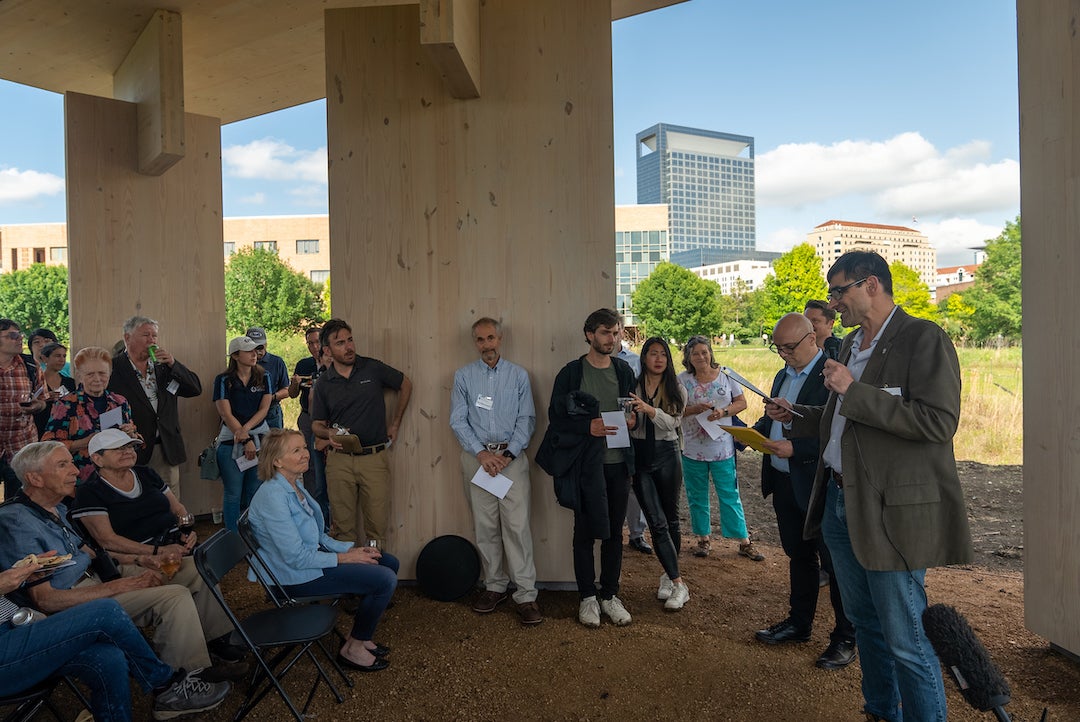The Johnson Owl Deck at Harris Gully was introduced to the Rice community during a grand opening and dedication April 27.
The new wildlife observation pavilion, made of cross-laminated timber and located on one of the most biodiverse university campuses in the country, represents the first step in creating a world-class natural area while exemplifying the possibilities of a new sustainable construction method. The project was developed in Associate Professor Jesús Vassallo's wood seminar at Rice Architecture by a team formed by Rice alums Pouya Khadem and Lene Sollie in collaboration with structural engineer Tracy Huynh.
“The Johnson Owl Deck fuses not only the beauty of architectural and landscape design, but also ecology and the natural sciences,” said Igor Marjanović, the William Ward Watkin Dean of Rice Architecture. “It is a truly interdisciplinary exercise in design research, technological innovation and ecological stewardship.
“The fact that the pavilion originated in a class taught by Jesús Vassallo speaks to the practical agency of architecture to generate new forms of knowledge and bring people together. The area around the pavilion will be further enhanced later this year with the addition of landscape design by Assistant Professor Maggie Tsang, resulting in a beautiful integration of architecture and ecology — the city and nature.”

Funding for the project was provided by a gift to the Wiess School of Natural Sciences from Judy and Michael Johnson, a federal grant from the U.S. Forest Service and support from the Lynn R. Lowrey Arboretum Committee at Rice.
“The Johnson Owl Deck is made possible in large part due to the generosity of Judy and Michael Johnson, for whom that pavilion is named,” said Thomas Killian, dean of the Wiess School of Natural Sciences. “The Johnsons have been great supporters of student programs, underwriting field trips and opening their home in New Mexico to visiting students.”
A key factor in the project was the mass timber wood construction process used for the structure — which limits the emission of carbon dioxide into the environment.
“With larger structural members that can be made with mass timber, you can start to replace some of the steel and concrete in the construction industry. Steel and concrete are the most carbon-intensive materials and the reason why the construction industry is one of the major contributors to global warming to carbon emissions,” Jesús Vassallo said. “With materials like mass timber, we can tackle the problem of the energy consumption and the carbon emissions for the construction of the buildings by using materials that instead of being carbon-positive are actually carbon-negative.”
The Johnson Owl Deck also wouldn’t have been possible without the support of Cin-Ty Lee and Cassidy Johnson, professors within the Wiess School of Natural Sciences, Vassallo said. Lee and Johnson have been instrumental in the preservation of Harris Gully and in finding ways to attract more people to the area.
“We’re trying to bring more attention to Harris Gully,” Lee said. “Many of us at Rice, but also beyond Rice in the community, want to preserve that area and make it accessible to everyone, because it's really the only green space left on campus, and it attracts lots of birds and insects and has a lot of plants.”

Students in Johnson's conservation biology lab have also played a large role in restoration efforts at the gully. Since 2015, the lab has studied the biodiversity of the site, leading to proposed restoration measures and an active research project.
“Through these activities, the students are learning how valuable urban conservation is to the protection of biodiversity and city ecosystem services,” Johnson said.
The gully consists of several microhabitats, from open prairie to open woodland to dense shrubland. Students and faculty have recorded over 250 species of birds on campus, as well as over 300 types of plants, more than 700 kinds of insects and five breeds of amphibians and reptiles.
Its biodiversity makes Harris Gully an ideal location to meditate or experience nature, including watching for birds.
“During migration, birds funnel into Harris Gully and they feed on the insects or the fruits — we now have a number of mulberry trees there and they come in and eat those,” Lee said. “A large community of people have been built around this and come to Rice to look for birds and other parts of nature fairly regularly.”
Drivers of the Johnson Owl Deck project hope the space continues to serve as an outdoor classroom and laboratory for students to learn about Earth, its environment and the life it harbors for years to come.
“The Owl Deck enables academic conversations and research while also providing a unique and peaceful setting for contemplation and connection with self and one's mental health,” said George Ristow, university architect and chair of the Arboretum Committee. “This project is undoubtedly a huge catalyst for the mission of the arboretum and it will enhance awareness and programming for a space that not every student knows about when they arrive on Rice’s campus for the first time.”






